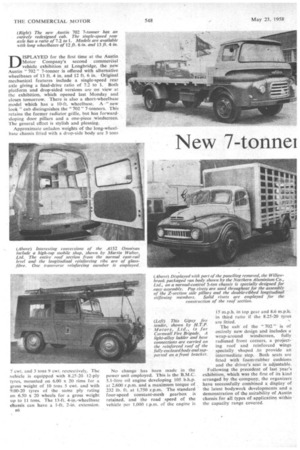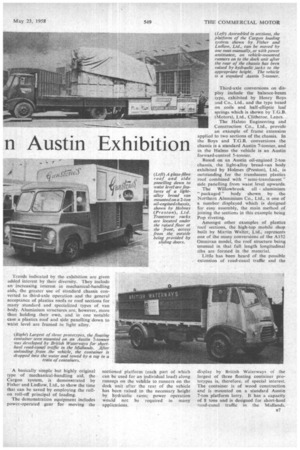New 7-tonnei n Austin Exhibition
Page 40

Page 41

If you've noticed an error in this article please click here to report it so we can fix it.
DISPLAYED for the first time at the Austin Motor Company's second commercial vehicle exhibition at Longbridge, the new Austin " 702 " 7-tonner is offered with alternative wheelbases of 13 ft. 4 in. and 12 ft. 6 in. Original mechanical features include a single-speed rear axle giving a final-drive ratio of 7.2 to 1. Both platform and drop-sided versions are on view at the exhibition, which opened last Monday and closes tomorrow. There is also a short-wheelbase model which has a 10-ft. wheelbase. A " new look" cab distinguishes the "702" 7-tonners. This retains the former radiator grille, but has forwardsloping door pillars and a one-piece windscreen. The general effect is stylish and pleasing.
Approximate unladen weights of the long-wheelbase chassis fitted with a drop-side body are 3 tons
7 cwt. and 3 tons 9 cwt. respectively,. The _vehicle is equipped with 8.25-20 12-ply tyres, mounted on 6,00 x 20 rims for a gross weight of 10 tons 5 cwt. and With 9.00-20 tyres of the same ply rating on 6.50 x 20 wheels for a gross weight up to 11 tons. The 13-ft. 4-in.-wheelbase chassis can have a 1-ft. 2-in, extension.
n6 No change has been made in the power unit employed. This is the B.M.C. 5.1-litre oil engine developing 105 b.h.p. at 2.600 r.p.m. and a maximum torque of . 232 lb. ft. at 1.750 r.p.m. The standard four-speed constant-mesh gearbox is retained, and the road speed of the vehicle per 1,000 r.pm. of the engine is 15 m.p.h. in top gear and 8.6 m.p.h. in third ratio if the 8.25-20 tyres are fitted.
The cab of the " 702 " is of entirely new design and includes a wrap-around windscreen, fully radiused front corners, a projecting roof and reinforced wings specially -shaped .to provide an intermediate step. Both seats are fitted with foam-rubber cushions and the driver's seat is adjustable.
Following the precedent of last year's exhibition, which was the first of its kind arranged by the company, the organizers have successfully combined a display of the latest bodywork developments and a demonstration of the suitability of Austin chassis for all types of application within the capacity range covered. Trends indicated by the exhibition are given added interest by their diversity. They include an increasing interest in mechanical-handling aids, the greater use of standard chassis converted to third-axle operation and the general acceptance of plastics roofs or roof sections for many standard and specialized types of van body. Aluminium structures are, however, more than holding their own, and in one notable case a plastics roof and side panelling down to waist level are framed in light alloy.
'A basically simple but highly original type of mechanical-handling aid, the Cargon system, is demonstrated by Fisher and Ludlow, Ltd., to show the time that can be saved by employing the rollon roll-off principal of loading.
The demonstration equipment includes power-operated gear for moving the
sectioned platform (each part of which can be used for an individual load) along runners on the vehtcle to runners on the deck unit after the rear of the vehicle has been raised to the necessary height by hydraulic rams; power operation would not be required in many applications.
Third-axle conversions on display include the balance-beam type, exhibited by Henry Boys and Co., Ltd., and the type based on coils and half-elliptic leaf springs which is shown by T.G.B. (Motors), Ltd., Clitheroe, Lancs.
The Halmo Engineering and Construction Co., Ltd., provide an example of frame extension applied to two sections of the chassis. In the Bays and T.G.B. conversions the chassis is a standard Austin 7-tonner, and in the Halmo the vehicle is an Austin forward-control 5-tonner.
Based on an Austin oil-engined 2-ton chassis, the light-alloy bread-van body exhibited by Holmes (Preston), Ltd., is outstanding for the translucent plastics roof combined with " semi-translucent " side panelling from waist level upwards.
The Willowbrook all aluminium " packaged " body shown by the Northern Aluminium Co., Ltd., is one of a number displayed which is designed for easy assembly, the main method of joining the sections in this example being Pop riveting.
Amongst other examples of plastics roof sections. the high-top mobile shop built by Martin Walter, Ltd., represents one of the many conversions of the A152 Omnivan model, the roof structure being unusual in that full length longitudinal ribs are formed in the material.
Little has been heard of the possible extension of road-canal traffic and the display by British Waterways of the largest of three floating container prototypes is, therefore, of special interest. The container is of wood construction and is mounted on a standard Austin 7-ton platform lorry. It has a capacity of 8 tons and is designed for short-haul road-canal traffic in the Midlands,
























































































